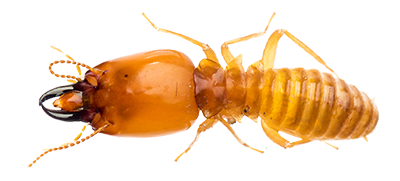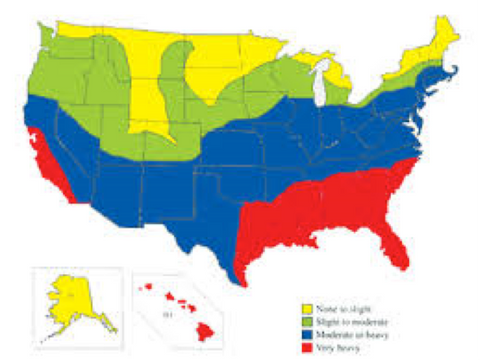More than 2,600 species of termites comprise the order Isoptera which live in large underground colonies and forage the top 24 inches of soil to ingest and decompose wood and other cellulose-based materials. In the soil they physically redistribute soil materials and are important for a healthy environment.

Only 183 species of termites cause damage to wood structures and about 45 of those species are found in the Continental United States. Of the three types of wood destroying termites (drywood, dampwood and subterranean) subterranean termites are considered major wood destroying pests in many states including California, Arizona, Oklahoma and throughout the Southeast. On the map below, Blue (moderate to heavy) and Red (very heavy) identify areas where subterranean termites pose a serious risk to wood poles and cause significant damage to wood structures in contact with the ground. Accelerated wood rot in utility poles can be caused by termites attacking the poles within 18 inches of the ground level which allows moisture penetration into the wood followed by rapid wood rot.

Different species of termites populate different areas of each state. In California for instance the genera Reticulitermes is the most widespread. In the Sonoran Desert of southeastern California and throughout Arizona, Heterotermes aureus predominates as the greatest pest.
The most destructive species in this group, the Formosan subterranean termite, Coptotermes formosanus, is native to China but now is established in most of the Southeastern states and some areas in California. Unlike the Reticulitermes but similar to Heterotermes, Formosan subterranean termites swarm at dusk and are attracted to lights.
In Hawai‘i the Formosan subterranean termite colonies lowered the life-cycle of wood utility poles to 7 to 20 years. Although termites move into new areas slowly, the transportation of infested wood inadvertently creates new colonies that, once established, remain in place forever. The Formosan subterranean termite, was accidentally introduced in these areas often by discarded wood from ship repair in ports or by movement of wood such as old railroad ties. Formosans are now is found in nine southern states. Since 1993, several dozen infestation sites have been found in Georgia.
The best resource to gain understanding about subterranean termites is the University Extension Service serving the local area. For instance, The University of Arizona Cooperative Extension has current information on Arizona termites. Dr. Vernard Lewis from U.C. Berkeley is a highly respected researcher on California subterranean termites. Each state will have this type of resource that is available to a utility company.